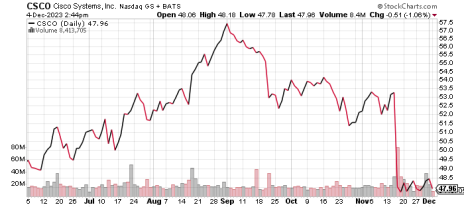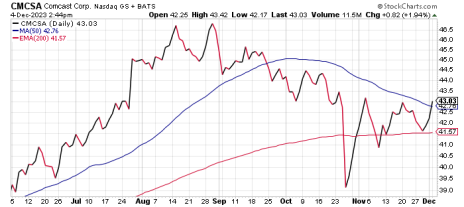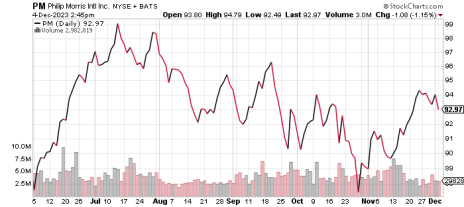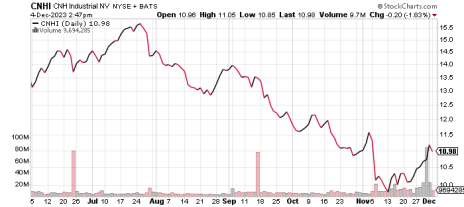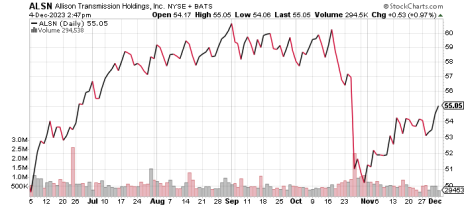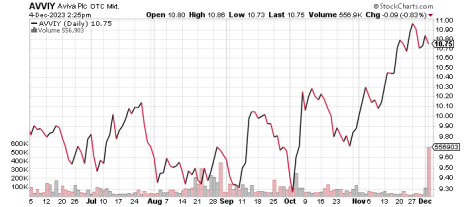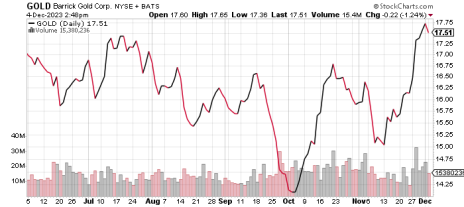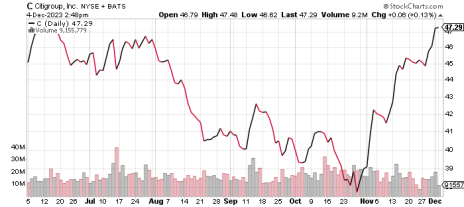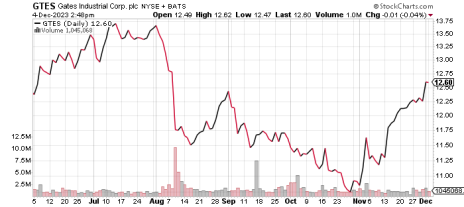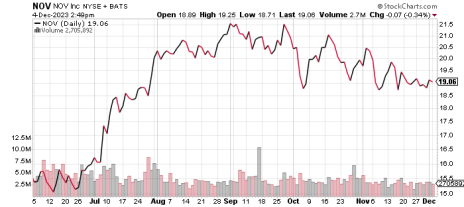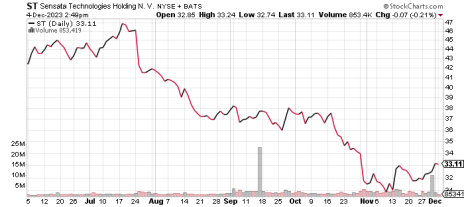Tonight We’re Gonna Party Like It’s…
It’s a whole new world. A recently developed, awe-inspiring technology is on its way to replacing millions of jobs while bringing immense profits and prosperity to the shareholders of companies that create or aggressively adopt this new wonder. Irrelevance followed by eventual collapse is the inevitable fate of all who fail to join the program.
What are we talking about here? Today’s investor might think we are talking about artificial intelligence – the new wonder-tech that is powering Nvidia (NVDA) and other Magnificent Seven stocks that have surged by an average of 102% this year. Yes, of course we are.
We are also talking about dot-com stocks of 23 years ago. The dream of the Internet drove the Nasdaq 100 index to nearly a double in 1998 and more than a double the following year. Other dreams rode the railroad stocks in the late 1800s, radio stocks in the 1920s, electronics stocks in the 1950s and personal computer stocks in the 1980s.
So here we are, partying again like we did in 1999 (and other exuberant eras). Anyone not joining the party is clearly out of step with the times. These sad luddites clearly don’t understand that things are different, now that AI will revolutionize business and society, probably starting this afternoon. And, of course, we know for sure who the winners will be – today and throughout the coming decades. Nothing will stop these companies. Their share prices are destined to provide 30%, 50%, 100% annualized returns far into the future.
Railroads, radios, electronics, PCs, the Internet and other new technologies did go on to revolutionize business and society. However, the leading companies’ share prices were universally on the losing end of their own revolution, as investor hype succumbed to gravity and reality.
AI-focused momentum investors today are forgetting that the lyrics(1) right before “… tonight we’re gonna party like it’s 1999…” was “2000 zero-zero party over, oops, out of time.”
It’s impossible to predict when the current party will end. As value investors, we’re finding impressive bargains in plain old industrial companies that partiers have tossed aside. CNH Industrial (CNHI) is one of these discarded stocks. See our commentary below on our new Buy recommendation of this interesting and undervalued company.
(1) Lyrics © Prince, “1999” Warner Bros Records.
Share prices in the table reflect Monday, December 4 closing prices. Please note that prices in the discussion below are based on mid-day December 4 prices.
Note to new subscribers: You can find additional color on past earnings reports and other news on recommended companies in prior editions and weekly updates of the Cabot Value Investor on the Cabot website.
Send questions and comments to Bruce@CabotWealth.com.
Today’s Portfolio Changes
New BUY on November 30 via Alert – CNH Industrial (CNHI)
Comcast Corp (CMCSA) – Moving shares from BUY to HOLD.
Portfolio Changes Since Last Month
Sensata Technologies (ST) – Moving shares from Buy to Hold.
Growth & Income Portfolio
Growth & Income Portfolio stocks are generally higher-quality, larger-cap companies that have fallen out of favor. They usually have some combination of attractive earnings growth and an above-average dividend yield. Risk levels tend to be relatively moderate, with reasonable debt levels and modest share valuations.
| Stock (Symbol) | Date Added | Price Added | 12/4/23 | Capital Gain/Loss | Current Dividend Yield | Price Target | Rating |
| Cisco Systems (CSCO) | 11/18/20 | 41.32 | 47.92 | 16.00% | 3.30% | 66 | Buy |
| Comcast Corp (CMCSA) | 10/26/22 | 31.5 | 42.98 | 36.40% | 2.70% | 46 | Hold |
| Philip Morris International (PM) | 9/18/23 | 96.79 | 93.01 | -3.90% | 5.60% | 120 | Buy |
Current price | 2023 EPS Estimate | 2024 EPS Estimate | Change in 2023 Estimate | Change in 2024 Estimate | P/E 2023 | P/E 2024 | |
| CSCO | 47.97 | 3.88 | 4.03 | 0.0% | 0.0% | 12.4 | 11.9 |
| CMCSA | 43.23 | 3.92 | 4.31 | -0.1% | 0.4% | 11.0 | 10.0 |
| PM | 94.36 | 6.12 | 6.50 | 0.0% | 0.0% | 15.4 | 14.5 |
Strong Buy – This stock offers an unusually favorable risk/reward trade-off, often one that has been rated as a Buy yet the market has sold aggressively for temporary reasons. We recommend adding to existing positions.
Buy – This stock is worth buying.
Hold – The shares are worth keeping but the risk/return trade-off is not favorable enough for more buying nor unfavorable enough to warrant selling.
Sell – This stock is approaching or has reached our price target, its value has become permanently impaired or changes in its risk or other traits warrant a sale.
Note for stock table: For stocks rated Sell, the current price is the sell date price.
Cisco Systems (CSCO) is facing revenue pressure as customers migrate to the cloud and thus need less of Cisco’s equipment and one-stop-shop services. Cisco’s prospects are starting to improve under a relatively new CEO, who is shifting Cisco toward a software and subscription model and is rolling out new products, helped by its strong reputation and entrenched position within its customers’ infrastructure. The company is highly profitable and generates vast cash flow (which it returns to shareholders through dividends and buybacks). Its announced deal for Splunk will drain most of its cash hoard but we see this as being replenished relatively quickly.
On November 15, Cisco reported impressive first-quarter fiscal 2024 results, with earnings of $1.11/share rising 29% from a year ago and beating the $1.03 estimate by 8%. However, guidance for second-quarter and full-year 2024 pointed to weak results that were below estimates, which pushed the shares down 10% in the following trading days.
In the quarter, revenues rose 8% and were in line with estimates. Software revenue increased 13%, indicating more progress with Cisco’s transition away from reliance on hardware. Backlog (termed “Remaining Performance Obligations”) rose 12%. The 67.1% gross margin compared to 63.0% a year ago – the jump was a huge reversal from chronic margin weakness and was the highest in 17 years. Higher productivity, lower shipping and lower component costs as well as favorable mix and pricing drove the sharp improvements.
Operating expenses were reasonably restrained, rising 5%. Higher gross profits and restrained operating expenses flowed to higher operating profits. The resulting 36.6% non-GAAP operating margin was impressively strong compared to 31.6% a year ago. Cisco’s balance sheet and cash flow appear as strong as ever.
Behind the weak guidance: Cisco said that its customers are digesting a heavy inflow of tech deliveries. The logic is essentially like a pig moving through a python (or, in this case, goods through the supply chain). During the pandemic, Cisco’s suppliers were unable to deliver sufficient components, creating a logjam at the suppliers. As suppliers eventually delivered more, the logjam moved to Cisco. Now, as Cisco is able to deliver better, the logjam has moved to customers. In response, customers are ordering less (orders were down 20% at Cisco in the quarter), so Cisco’s revenues in the next two quarters will be subdued as this logjam is cleared.
Cisco said that once the logjam is cleared, its regular growth pattern should re-emerge. However, this means that 2024 revenues and profits will be flat compared to a year ago, unless the recovery happens faster.
We’re mostly OK with management’s reasons (they provided some reasonable evidence on the call) but are left to wondering how much is due to macro weakness. The secular case for tech upgrades remains as strong as ever, but budgets may be squeezed, which will limit spending.
Cisco’s guidance contained a favorable nugget: that the company’s core profitability seems to have permanently ticked up. Guidance for 2024 implies operating margins of close to 35%, meaningfully higher than the 31.5% rate for each of the past three years.
We suspect that the guide-down for the year is conservative enough to preclude any more guidance cuts through at least the end of the fiscal year in August 2024. The effects of the Splunk deal are widely known and will likely be highly touted as the closing approaches next year. For now, no change to our Cisco rating.
There was no significant company-specific news in the past week.
CSCO shares were flat in the week and have 38% upside to our 66 price target. Based on fiscal 2024 estimates, unadjusted for the Splunk acquisition, the valuation is attractive at 8.9x EV/EBITDA and 12.4x (on July 2024) earnings per share. BUY
Comcast Corporation (CMCSA) – Comcast is one of the world’s largest media and entertainment companies. Its properties include Comcast cable television, NBCUniversal (movie studios, theme parks, NBC, Telemundo and Peacock), and Sky media. The Roberts family holds a near-controlling stake in Comcast. Comcast shares have tumbled due to worries about cyclical and secular declines in advertising revenues and a secular decline in cable subscriptions as consumers shift toward streaming services, as well as rising programming costs and incremental competitive pressure as phone companies upgrade their fiber networks.
However, Comcast is a well-run, solidly profitable and stable company that will likely continue to successfully fend off intense competition while increasing its revenues and profits, as it has for decades. The company generates immense free cash flow which is more than enough to support its reasonable debt level, generous dividend and sizeable share buybacks.
Peacock is now available as a free streaming service to Instacart+ members. For now, at least, Peacock is the only streaming service with this arrangement. We see this as an incremental positive – it will almost certainly boost Peacock’s subscriber count yet also shows some creativity on Comcast’s part to expand its reach.
Comcast shares rose 3% in the past week and have 6% upside to our 46 price target. As the shares approach our price target, we are moving our rating to HOLD.
Philip Morris International (PM) – Based in Connecticut, Philip Morris owns the global non-U.S. rights to sell Marlboro cigarettes, the world’s best-selling cigarette brand. Cigarettes comprise about 65% of PMI’s revenues. The balance of its revenues is produced by smoke-free tobacco products. The cigarette franchise produces steady revenues and profits while its smoke-free products are profitable and growing quickly. The upcoming full launch of IQOS products in the United States, a wider launch of the IQOS ILUMA product and the recent $14 billion acquisition of Swedish Match should help drive new growth.
The company is highly profitable, generates strong free cash flow and carries only modestly elevated debt (at about 3.2x EBITDA) which it will whittle lower over the next few years. The share valuation at about 13.5x EBITDA and 15.6x per-share earnings is too low in our view. Primary risks include an acceleration of volume declines and/or deteriorating pricing, higher excise taxes, new regulatory or legal issues, slowing adoption of its new products, and higher marketing costs. A strong U.S. dollar will weigh on reported results. While unlikely, Philip Morris could acquire Altria, thus reuniting the global Marlboro franchise.
There was no significant company-specific news in the past week.
PM shares were unchanged in the past week and have 27% upside to our 120 price target. The shares offer an attractive 5.5% dividend yield. BUY
Buy Low Opportunities Portfolio
Buy Low Opportunities Portfolio stocks include a wide range of value opportunities. These stocks carry higher risk than our Growth & Income stocks yet also offer more potential upside. This group may include stocks across the quality and market cap spectrum, including those with relatively high levels of debt and a less-clear earnings outlook. The stocks may not pay a dividend. In all cases, the shares will trade at meaningful discounts to our estimate of fair value.
| Stock (Symbol) | Date Added | Price Added | 12/4/23 | Capital Gain/Loss | Current Dividend Yield | Price Target | Rating |
| Allison Transmission Hldgs (ALSN) | 2/22/22 | 39.99 | 54.94 | 37.40% | 1.70% | 59 | Buy |
| Aviva (AVVIY) | 3/3/21 | 10.75 | 10.75 | 0.00% | 7.40% | 14 | Buy |
| Barrick Gold (GOLD) | 3/17/21 | 21.13 | 17.5 | -17.20% | 2.30% | 27 | Buy |
| Citigroup (C) | 11/23/21 | 68.1 | 47.23 | -30.60% | 4.50% | 85 | Buy |
| CNH Industrial (CNHI) | 11/30/23 | 10.74 | 10.98 | 2.20% | 3.60% | 15 | New Buy |
| Gates Industrial Corp (GTES) | 8/31/22 | 10.72 | 12.6 | 17.50% | 0.00% | 16 | Buy |
| NOV, Inc (NOV) | 4/25/23 | 18.8 | 19.04 | 1.30% | 1.10% | 25 | Buy |
| Sensata Technologies (ST) | 2/17/21 | 58.57 | 33.06 | -43.60% | 1.50% | 57 | Hold |
| Current Price | 2023 EPS Estimate | 2024 EPS Estimate | Change in 2023 Estimate | Change in 2024 Estimate | P/E 2023 | P/E 2024 | |
| ALSN | 54.23 | 6.96 | 7.27 | 0.0% | 0.0% | 7.8 | 7.5 |
| AVVIY | 10.79 | 0.37 | 0.45 | 1.6% | 2.0% | 29.2 | 23.9 |
| GOLD | 17.44 | 0.83 | 1.10 | 0.1% | 0.3% | 21.0 | 15.9 |
| C | 47.25 | 6.01 | 5.93 | 0.0% | 0.0% | 7.9 | 8.0 |
| CNHI | 10.90 | 1.69 | 1.60 | na | na | 6.4 | 6.8 |
| GTES | 12.56 | 1.25 | 1.37 | 0.0% | 0.0% | 10.1 | 9.2 |
| NOV | 19.23 | 1.42 | 1.71 | 0.0% | 0.0% | 13.6 | 11.2 |
| ST | 32.77 | 3.65 | 3.99 | 0.0% | -0.1% | 9.0 | 8.2 |
Strong Buy – This stock offers an unusually favorable risk/reward trade-off, often one that has been rated as a Buy yet the market has sold aggressively for temporary reasons. We recommend adding to existing positions.
Buy – This stock is worth buying.
Hold – The shares are worth keeping but the risk/return trade-off is not favorable enough for more buying nor unfavorable enough to warrant selling.
Sell – This stock is approaching or has reached our price target, its value has become permanently impaired or changes in its risk or other traits warrant a sale.
Note for stock table: For stocks rated Sell, the current price is the sell date price.
New BUY as of November 30 Alert: We are recommending shares of CNH Industrial (CNHI) as a new Buy. The company is a major producer of agriculture (80% of sales) and construction (20% of sales) equipment for customers around the world and is the #2 ag equipment producer in North America (behind Deere). It also provides related supplies, services and financing.
The shares have slid over 40% from their peak at the end of 2021 and now trade essentially unchanged over the past 20 years. A major reason for the price decline is concern that the ag and construction cycle has peaked and is slipping toward a major downturn. This worry was heightened when the company missed estimates for the most recent quarter, guided for weaker-than-expected fourth-quarter results and offered an uninspiring preliminary outlook for 2024.
While investors see an average cyclical company at the cusp of a downturn, with a complicated history and share structure, we see a high-quality and financially strong company that is improving its business prospects and is simplifying itself yet whose shares are trading at a highly discounted price.
CNH generates over $20 billion in revenues, supported by its high-quality brands that include Case IH and New Holland. The company is highly profitable, with earnings expected to be $2.1 billion this year. Free cash flow for its Industrial operations will be over $1.2 billion. The Industrial segment balance sheet carries $3.7 billion in cash compared to its $4.6 billion in debt. CNH’s financial segment, whose only business is providing financing for end-customers and dealers of its equipment, is conservatively capitalized (9.7% equity ratio) and generates a 12-13% return on equity.
The ag equipment industry is seeing weakness overseas and will likely see some weakness in North America. A modest global downturn is likely in 2024. However, we don’t anticipate a deep downturn, given the stability of commodity prices, enduring demand for crops, and the growing need for more productive equipment.
While its products have lagged technologically, CNH equipment is catching up quickly. Its field equipment has always been competitive yet lacked newer precision technologies that help farmers become more efficient. It relied on Trimble (TRMB) for much of its technology. Now, however, CNH is bringing much of this capability in-house, helped by two acquisitions. This shift should boost its competitiveness while potentially increasing its margins.
Under relatively new leadership, Scott Wine, the CEO who previously led Polaris (PII) to success, is implementing efficiency programs totaling about $800 million (nearly 4% of revenues) to make CNH more profitable at all points in the cycle. Removing the legacy inefficiencies from its Iveco era is a key component of these programs.
CNH Industrial has a complicated history, which has led American investors to avoid its stock, and has fostered the inefficient cost structure. Its roots are in two ag equipment companies, J.I. Case and International Harvester, which merged in 1985. This company was then acquired by Italian company Fiat in 1999 and combined with Fiat’s New Holland business to become Case New Holland (CNH). In 2012, Fiat added its Iveco truck, bus and engines business to create CNH Industrial, but this move was reversed in 2021. Today, CNH Industrial is purely an agriculture and construction equipment company. This clarity should eventually lift the shares’ valuation.
Further burdening investor interest is that CNHI shares trade in Milan (a legacy of its Fiat days) and New York. However, the company is de-listing its shares from Milan and transitioning all of its share trading to the New York Stock Exchange, effective in early 2024. This should remove the two-country overhang. Near-term, this transition is likely weighing on the share price as Milan traders unwind their positions, so CNH is implementing a $1 billion share buy-back program, with a completion date of March 31, 2024. For perspective, the $1 billion would repurchase about 7% of the company’s shares.
We would like to see more clean-up of the company’s legal structure. Its operational headquarters is near Chicago, while its legal headquarters are in London and its registration is in the Netherlands. Ideally, the company would centralize all of these into the United States. Also, we would like to see the dividend changed from a single annual dividend to a recurring quarterly dividend to better correspond to American standards.
Adding credibility to the company and our thesis is the presence of two major investor-friendly shareholders. The Agnelli family, who controls Fiat, remains a 28% owner and is highly regarded for its investment savvy. Harris Associates, a noted value-focused American investment management firm, holds a 9.3% stake and recently added to its position.
The company’s shares trade at 6.1x per-share earnings. This compares to 12x for Deere and Caterpillar and 7x for Agco. On an EBITDA basis, assuming only book value for the financial segment, CNH’s shares trade at 4.2x EV/EBITDA – also a sizeable discount to its peers. The shares offer an attractive 3.7% dividend yield that looks well-supported by cash flow and the balance sheet.
CNHI shares carry risks that potential investors should know about. The major risk is that equipment cycles can be unpredictable and deeper than expected. A deep cycle could drag the company’s earnings much lower and push the shares to perhaps $6. Other risks include production costs, new trade barriers, currency changes and general execution.
All-in, the shares look attractive, and we are recommending them as a Buy with a $15 price target. Investors may want to gradually build their positions – establishing a partial position now and adding on any further weakness, particularly around earnings reports.
Allison Transmission Holdings, Inc. (ALSN) – Allison Transmission is a midcap manufacturer of vehicle transmissions. While many investors view this company as a low-margin producer of car and light truck transmissions that is destined for obscurity in an electric vehicle world, Allison actually produces no car or light truck transmissions. Rather, it focuses on the school bus and Class 6-8 heavy-duty truck categories, where it holds an 80% market share. Its EBITDA margin is sharply higher than its competitors and on par with many specialty manufacturers. And, it is a leading producer and innovator in electric axles which all electric trucks will require. The company generates considerable free cash flow and has a low-debt balance sheet. Its capable leadership team keeps its shareholders in mind, as the company has reduced its share count by 38% in the past five years.
There was no significant company-specific news in the past week.
ALSN shares were flat in the past week and have 9% upside to our $59 price target. The shares offer a reasonable 1.7% dividend yield. BUY
Aviva, plc (AVVIY), based in London, is a major European company specializing in life insurance, savings and investment management products. Amanda Blanc, hired as CEO in July 2020, is revitalizing Aviva’s core U.K., Ireland and Canada operations following her divestiture of other global businesses. The company now has excess capital which it is returning to shareholders as likely hefty dividends following a sizeable share repurchase program. While activist investor Cevian Capital has closed out its previous 5.2% stake, highly regarded value investor Dodge & Cox now holds a 5.0% stake, providing a valuable imprimatur and as well as ongoing pressure on the company to maintain shareholder-friendly actions.
On November 16, Aviva provided its third-quarter trading update. Revenues grew at a healthy pace in two major segments, including General Insurance (+13%) and Protection & Health (+23%). Retirement segment growth was positive but not stellar (+2%). Wealth assets had YTD net inflows of new assets equal to 6% of total assets, down 9% from the pace a year ago. Aviva continues to develop its businesses that require less capital support, which allows the company to distribute the excess capital back to shareholders as dividends and buybacks.
The YTD combined operating ratio – an indicator of profitability – improved incrementally from a year ago. Management reiterated their 2023 target of growing operating profit by 5-7% this year, despite some unusual losses due to Canadian wildfires and two hurricanes, indicating that overall profit growth remains healthy. Capital and related financial strength ratios continue to be robust.
Aviva reiterated its confidence in paying a roughly 33.4 pence/share dividend. The company also maintained its confidence in meeting its medium-term financial targets.
There was no significant company-specific news in the past week.
Aviva shares fell 2% this past week and have 30% upside to our 14 price target. Based on management’s guidance for the 2023 dividend, which we believe is a sustainable base level, the shares offer a generous 7.9% yield. On a combined basis, the dividend and buybacks offer more than a 10% “shareholder yield” to investors. BUY
Barrick Gold (GOLD), based in Toronto, is one of the world’s largest and highest-quality gold mining companies. About 50% of its production comes from North America, with the balance from Africa/Middle East (32%) and Latin America/Asia Pacific (18%). Barrick will continue to improve its operating performance (led by its highly capable CEO), generate strong free cash flow at current gold prices, and return much of that free cash flow to investors while making minor but sensible acquisitions. Also, Barrick shares offer optionality – if the unusual economic and fiscal conditions drive up the price of gold, Barrick’s shares will rise with it. Given their attractive valuation, the shares don’t need this second (optionality) point to work – it offers extra upside. Barrick’s balance sheet has nearly zero debt net of cash. Major risks include the possibility of a decline in gold prices, production problems at its mines, a major acquisition and/or an expropriation of one or more of its mines.
Investors might want to check out the recent Youtube video, “Gold: A Journey with Idris Elba,” available here. Produced by the World Gold Council, the video promotes a favorable view of gold and gold mining. However, it also provides some interesting visuals into what is involved in mining gold and features Barrick’s massive mine in Africa, along with other major gold miners’ mines.
Over the past week, commodity gold rose 3% to $2,068/ounce, after touching a record high $2,137. While gold prices seemed stuck between about $1,800 and $2,000, the recent surge suggests that gold may be making a step up in its price range. Part of the jump could be related to lower actual and expected interest rates. The 10-year Treasury yield slid to 4.25%, down 20 basis points in a week.
The structural forces behind inflation may be permanent – war, government spending, crime, oil prices and past-the-peak fading of the benefits of global free trade, in addition to tight labor market – which could keep inflation at the 3-5% pace indefinitely. Permanent inflation would imply permanent 4-6% interest rates. We see this as a reasonably acceptable normal, which is more in line with history than the 0-3% rates of the past decade.
The U.S. Dollar Index (the dollar and gold usually move in opposite directions) was fractionally higher at 103.61 but has clearly stepped down from its 106-107 range of a few months ago.
The U.S. Dollar Index reached a peak of 119 in early 2001, a price that is around 10% above the current level. The world is a very different place than it was in the pre-9/11 era, so we have no way to effectively compare conditions across this time span. However, today, we see global capital moving to the safety of US dollar assets relative to most other developed nation currencies. Gold may be seen as a lesser source of safety, partly due to its illiquidity.
Investors and commentators offer a wide range of outlooks for the economy, interest rates and inflation. We have our views but hold these as more of a general framework than a high-conviction posture. Investing in gold-related equities is a long-term decision – investors shouldn’t allow near-term weakness to deter their resolve.
Barrick shares rose 5% this past week, yet remain depressed despite gold prices reaching record highs, and have 55% upside to our 27 price target. BUY
Citigroup (C) – Citi is one of the world’s largest banks, with over $2.4 trillion in assets. The bank’s weak compliance and risk-management culture led to Citi’s disastrous and humiliating experience in the 2009 global financial crisis, which required an enormous government bailout. The successor CEO, Michael Corbat, navigated the bank through the post-crisis period to a position of reasonable stability. Unfinished, though, is the project to restore Citi to a highly profitable banking company, which is the task of new CEO Jane Fraser.
This week’s Barron’s included an article on Citi’s turnaround. The article highlighted the challenges that the company faces yet also some positives that include its relatively small unrealized bond portfolio losses ($34 billion) and its relatively small commercial real estate portfolio.
Investors have lost hope in Citigroup. The shares trade essentially unchanged from 2010 prices and are at or near lows not seen since 2012, only a few years after the worst of the global financial crisis. Valued at roughly 50% of tangible book value, Citi shares are pricing in what amounts to a ceiling on its earnings power of about $4.50-$5.00/share, based on the assumption that a roughly 8x multiple is “about right.” This perhaps is based on the 4Q23 estimate of $1.18/share being the permanent run-rate ($1.18 x 4 quarters = $4.72).
We find it hard to believe that Citi’s earnings won’t improve over the fourth quarter run rate. Not only are consensus annual estimates at $6/share, but the company is taking a more aggressive cost-cutting stance and its stronger segments continue to show growth.
Another way to look at the valuation: using the general rule of thumb that banks trade at a P/TBV that is 10x its return on tangible common equity, Citi shares are pricing in roughly $4.35/share of earnings. The rough math is that by valuing the shares at 50% of tangible book value, investors are assuming a 5.0% return on tangible common equity [5.0% x $87 TBV = $4.35 EPS]. While anything is possible, it would seem exceptionally unlikely that Citi would be stuck at $4.35/share of earnings.
The recently raised $0.53/share quarterly dividend looks sustainable outside of a devastating market calamity.
Citi shares rose 5% in the past week and have 80% upside to our 85 price target. The shares remain attractive as they trade at about 54% of tangible book value of $86.90. The dividend offers investors a 4.5% yield.
When comparing Citi shares with a U.S. 10-year Treasury bond, Citi offers a higher yield and considerably more upside price potential. Clearly, the Citi share price and dividend payout carry considerably more risk than the Treasury bond, but at the current valuation, Citi shares would seem to have a remarkably better risk/return trade-off. BUY
Gates Industrial Corp, plc (GTES) – Gates is a specialized producer of industrial drive belts and tubing. While this niche might sound unimpressive, Gates has become a leading global manufacturer by producing premium and innovative products. Its customers depend on heavy-duty vehicles, robots, production and warehouse machines and other equipment to operate without fail, so the belts and hydraulic tubing that power these must be exceptionally reliable. Few buyers would balk at a reasonable price premium on a small-priced part from Gates if it means their million-dollar equipment keeps running. Even in automobiles, which comprise roughly 43% of its revenues, Gates’ belts are nearly industry-standard for their reliability and value. Helping provide revenue stability, over 60% of its sales are for replacements. Gates is well-positioned to prosper in an electric vehicle world, as its average content per EV, which require water pumps and other thermal management components for the battery and inverters, is likely to be considerably higher than its average content per gas-powered vehicle.
The company produces wide EBITDA margins, has a reasonable debt balance and generates considerable free cash flow. The management is high-quality. In 2014, private equity firm Blackstone acquired Gates and significantly improved its product line-up and quality, operating efficiency, culture and financial performance. Gates completed its IPO in 2018. Following several sell-downs, Blackstone has a 43% stake today.
There was no significant company-specific news in the past week.
Gates shares rose 2% this past week and have 27% upside to our 16 price target. BUY
NOV, Inc (NOV) – This high-quality, mid-cap company, formerly named National Oilwell Varco, builds drilling rigs and produces a wide range of gear, aftermarket parts and related services for efficiently drilling and completing wells, producing oil and natural gas, constructing wind towers and kitting drillships. About 64% of its revenues are generated outside of the United States. Its emphasis on proprietary technologies makes it a leader in both hardware, software and digital innovations, while strong economies of scale in manufacturing and distribution as well as research and development further boost its competitive edge. The company’s large installed base helps stabilize its revenues through recurring sales of replacement parts and related services.
We see the consensus view as overly pessimistic, given the company’s strong position in an industry with improving conditions, backed by capable company leadership and a conservative balance sheet.
There was no significant company-specific news in the past week.
The price of West Texas Intermediate (WTI) crude oil continues to weaken and traded down another 4% to $72.68/barrel. The recent extension of the OPEC+ production cuts aren’t providing much if any support for oil prices, as investors worry that the U.S. economy is slowing and that North American oil production has returned to its previous peak. The Israel-Hamas conflict has so far had little to no effect on oil prices but recent attacks on a U.S. Navy ship by Houthi rebels may lead to an escalation.
Outcomes in wars are unpredictable. It would seem that the potential for sharp oil price volatility is higher with the increasingly complicated game of shifting geopolitical and economic alignments. A major new catalyst, in addition to all of the others, would be export or production cuts from the Middle East if Iran became directly or even explicitly indirectly involved (including if the U.S. restores its sanctions). Also, American sanctions on Venezuelan oil may return, which would provide at least modest support for oil prices.
The price of Henry Hub natural gas slid 9% to $2.65/mmBtu (million BTU). The near-term weather outlook points to warmer-than-expected temperatures while gas storage levels are high.
NOV shares were flat in the past week and have 30% upside to our 25 price target. The dividend produces a reasonable 1.0% dividend yield. BUY
Sensata Technologies (ST) is a $3.8 billion (revenues) producer of nearly 47,000 highly engineered sensors used by automotive (60% of revenues), heavy vehicle, industrial and aerospace customers. About two-thirds of its revenues are generated outside of the United States, with China producing about 21%. Investors undervalue Sensata’s durable franchise. Its sensors are typically critical components that generally produce high profit margins. As the sensors’ reliability is vital to safety and performance, customers are reluctant to switch to another supplier that may have lower prices but also lower or unproven quality. Sensata has an arguably under-leveraged balance sheet and generates healthy free cash flow. The relatively new CEO will likely continue to expand the company’s growth potential through acquisitions. Electric vehicles are an opportunity as they expand Sensata’s reachable market. Our Sensata investment remains an underperforming (from a business fundamentals perspective) work in progress.
There was no significant company-specific news in the past week.
The shares will likely remain weak or stagnant for the near term. We will wait for a favorable change in investor sentiment but are poised to pull the plug. ST shares rose 3% in the past week and have 74% upside to our recently reduced 57 price target. HOLD
Disclosure: The chief analyst of the Cabot Value Investor personally holds shares of every recommended security, except for “New Buy” recommendations. The chief analyst may purchase or sell recommended securities but not before the fourth day after any changes in recommendation ratings has been emailed to subscribers. “New Buy” recommendations will be purchased by the chief analyst as soon as practical following the fourth day after the newsletter issue has been emailed to subscribers.
The next Cabot Value Investor issue will be published on January 2, 2024.
